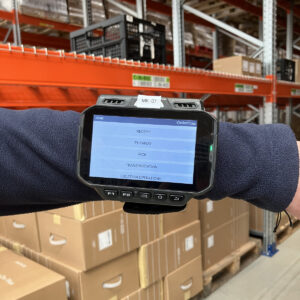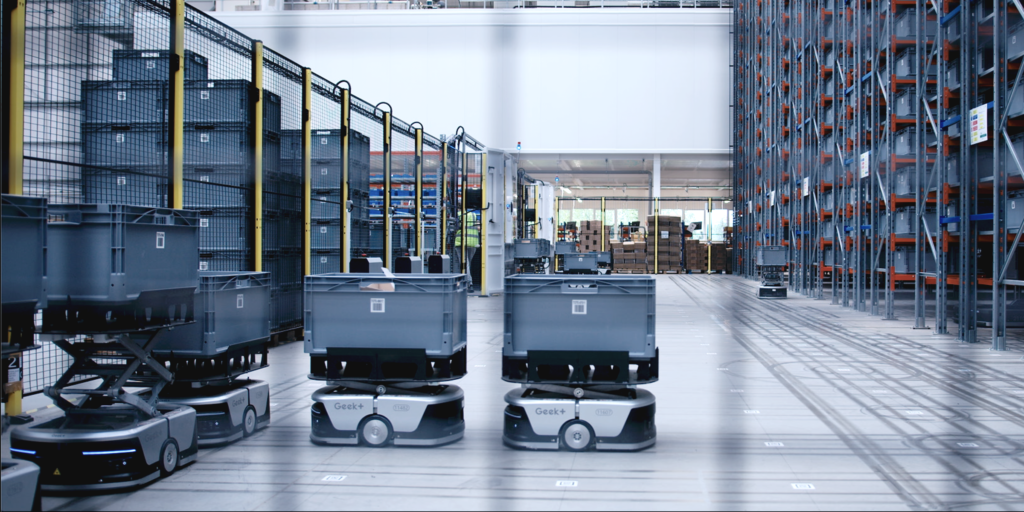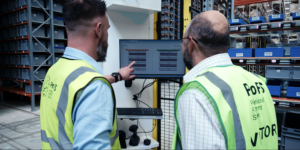The Evolution of E-Commerce Fulfilment Technology
Table of Contents
In the fast-paced world of e-commerce, businesses are constantly striving to meet rising customer expectations for speed, accuracy, and efficiency. Third party logistics (3PL) companies play a critical role in helping businesses achieve these goals by managing their logistics operations. Today, the most successful third party logistics companies are those that embrace advanced technology to deliver seamless and efficient services.
Gone are the days when third party logistics services were limited to basic warehousing and shipping. Modern 3PL providers integrate state-of-the-art technologies such as Warehouse Management Systems (WMS), Transportation Management Systems (TMS), real-time tracking, and automation to optimise logistics services. By leveraging these tools, 3PL companies can offer enhanced services, reduce operational costs, and improve e-commerce fulfilment processes.

This article delves into the cutting-edge technologies reshaping the 3PL logistics industry and highlights how these innovations are helping businesses streamline operations and scale efficiently.
Warehouse Management Systems (WMS): The Backbone of 3PL Warehousing
A Warehouse Management System (WMS) is the central hub for managing all 3PL warehousing activities, from inventory control to order processing. In a modern 3PL logistics company, the WMS is indispensable for ensuring that operations run smoothly and efficiently.
At its core, a WMS optimises space and resource allocation, tracks inventory levels in real-time, and facilitates efficient order fulfilment. By automating these processes, third party fulfilment companies can minimise human error, reduce labour costs, and speed up the fulfilment process. For e-commerce businesses, which often face unpredictable demand and seasonal fluctuations, a robust WMS ensures that products are always in stock, orders are fulfilled promptly, and customer expectations are met.
Moreover, advanced WMS solutions provide data analytics that can be used to make informed decisions on inventory management, space utilisation, and staffing levels. This data-driven approach allows 3PL providers to predict demand patterns, avoid stockouts, and ensure smooth e-commerce fulfilment operations even during peak seasons.
Transportation Management Systems (TMS): Optimising Delivery Networks
While a WMS handles operations within the warehouse, a Transportation Management System (TMS) focuses on logistics outside the warehouse. A TMS is a key tool for managing transportation logistics, optimising delivery routes, and controlling shipping costs.
For third party fulfilment companies, a TMS enables efficient coordination of deliveries, providing end-to-end supply chain visibility. With a TMS, businesses can optimise routes for quicker and more cost-effective deliveries, which is especially important for e-commerce fulfilment when striving to meet customer demands for fast shipping. Additionally, a TMS integrates with other systems to offer real-time tracking, ensuring businesses and customers alike have full visibility into the shipping process.
A key benefit of a TMS is its ability to automate the entire shipping process, from selecting carriers and creating shipping labels to tracking shipments and analysing delivery performance. By reducing manual processes, businesses can ensure timely and cost-effective deliveries while keeping customers informed of their orders in real time.
Real-Time Tracking and Analytics: Enhancing Transparency and Decision-Making

In today’s digital age, real-time tracking has become an essential component of modern logistics. For 3PL providers, the ability to track inventory movement and shipments in real-time ensures greater accuracy and visibility throughout the entire supply chain.
By offering real-time tracking capabilities, a 3PL logistics company can provide their clients with detailed insights into where their products are at any given moment. This level of transparency allows businesses to respond quickly to changes, manage customer expectations, and avoid costly delays. For example, if an unexpected delay occurs during shipping, real-time tracking allows both the 3PL provider and the business to take proactive measures to mitigate any potential disruptions.
Furthermore, real-time tracking is often combined with advanced analytics to provide actionable insights that can improve overall logistics performance. By analysing tracking data, a 3PL logistics company can identify inefficiencies, forecast demand, and optimise processes. For business owners, this data-driven approach helps them make informed decisions on inventory management, fulfilment strategies, and long-term planning.
Speak To An Expert
Have questions about how we can help your business grow?
Our experts are on hand to provide answers and guide you through the process.
The Benefits of Automation in E-Commerce Fulfilment
Automation has revolutionised the logistics industry, and third party fulfilment providers are at the forefront of this transformation. By automating key fulfilment processes, a 3PL logistics company can significantly increase efficiency, reduce costs, and improve the accuracy of order fulfilment.
One of the most impactful uses of automation in third party fulfilment is in the warehouse. Automated picking systems, for example, use robots to pick products for orders, reducing the need for manual labour. Similarly, automated packing systems streamline the packaging process, ensuring that orders are shipped more quickly and with fewer errors. By integrating these technologies, 3PL warehousing providers can handle larger volumes of orders while maintaining a high level of accuracy.
For e-commerce businesses experiencing rapid growth, automation allows their logistics operations to scale effortlessly. Automated systems ensure that fulfilment processes remain efficient even during periods of high demand, reducing the risk of bottlenecks or delays.

Data-Driven Decision-Making: Improving Accuracy and Forecasting
In the modern 3PL landscape, data is one of the most valuable assets for making strategic decisions. By leveraging data analytics, 3PL providers can optimise their operations, improve forecasting, and enhance overall accuracy.

Data analytics tools enable 3PL providers to analyse vast amounts of information collected from various sources, including WMS and TMS systems, real-time tracking tools, and customer feedback. This wealth of data provides insights into everything from inventory levels to delivery times, allowing providers to make proactive decisions about resource allocation, staffing, and process improvements.
For e-commerce businesses, data-driven decision-making is crucial for managing inventory and anticipating future demand. By using data to predict demand fluctuations, businesses can avoid overstocking or understocking issues, both of which can impact profitability. Additionally, accurate forecasting enables businesses to better prepare for seasonal peaks, ensuring that they have the resources in place to meet customer demand.
The Future of Third Party Fulfilment Lies in Technology
As the logistics industry continues to evolve, technology will remain the driving force behind innovation and improvement. From Warehouse Management Systems (WMS) and Transportation Management Systems (TMS) to real-time tracking, automation, and data analytics, third party fulfilment companies are leveraging cutting-edge solutions to provide businesses with more efficient, scalable, and transparent fulfilment services.
For e-commerce businesses, partnering with a technology-driven 3PL logistics company is essential for staying competitive in today’s marketplace. By choosing a 3PL company that embraces technological advancements, businesses can improve operational efficiency, reduce costs, and meet the growing demands of their customers.
Get in touch today to discuss how Pro FS – a technology-forward 3PL logistics company – can optimise your e-commerce fulfilment and support your business growth.


